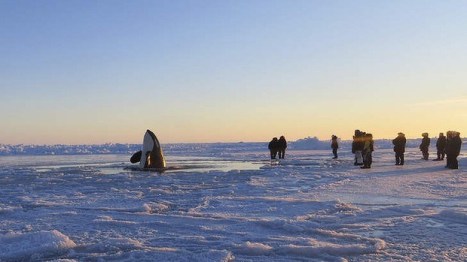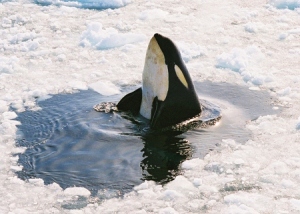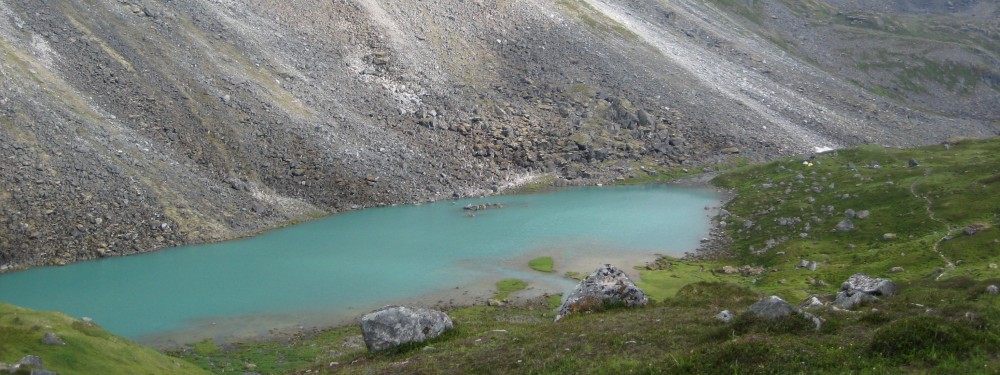
Villagers watch as a killer whale surfaces for air near Inukjuak, Quebec last week. (AP Photo/The Canadian Press, Marina Lacasse)
By Guest Blogger Bethann G. Merkle
Last week, while the world watched with bated breath, a pod of orcas (Orcinus orca) swam in an ever-shrinking zone of open water. Each time they came up for air, frigid water sloshed onto the surrounding ice and froze, compounding the problem little by little. Much farther north than normal for this time of year, the killer whales were clearly out of their element.
Caught in Hudson Bay when the water froze over, these giant ocean mammals were in a real fix. The story put the tiny northern Quebec village of Inukjuak on the map. CBC coverage, YouTube videos, and news feeds running the story as far away as the United Kingdom, Taiwan, and Australia contributed to a firestorm of media focus on the animals’ life-threatening predicament.
Depending on when you tuned in, you might have thought the villagers were going to save the whales by cutting holes in the ice — a highly dangerous endeavour on unpredictable floe ice. You might have heard that Fisheries Canada was going to send an icebreaker, or that global interest would raise enough concern and funds to make that a viable option. You might have heard listeners calling in to suggest that local hunters harvest the whales if there were no other options, and other callers rebutting the idea by stating those villagers have no tradition of harvesting killer whales. You might have seen online forums where people bemoaned the fact that humans could be so heartless as to ignore such a life-and-death plight, while others claimed this was a natural event that became known to the public only because of its proximity to a village.
Regardless of what you heard or saw, the situation raises some interesting questions. Where do we, as a species capable of concern, collaborative action, and logic draw the line? Should the government re-route icebreakers busy keeping shipping lanes open in order to save the lives of possibly a dozen animals swimming far beyond their normal range? Should the local villagers risk their lives for the dubious mission of opening more holes in the ice? Should listeners cozy in the relative southern climes have a say in what happens way up there in the frozen North? Does the synergy of social media and charismatic megafauna overwhelm the scientific reality that whales are likely trapped in the ice more often than we realize?

Ross Sea Killer Whale breaches in the Antarctic region. Photo credit: Jaime Ramos, National Science Foundation.
As majestic as a killer whale may be, should we forget that the simple facts of winter can render any animal powerless in a moment? Should we overlook this opportunity to stand in awe of the complexity of nature — natural events, the power of water in its different states, and the incorrigible human will to grapple with it all?
NOTE: These killer whales are part of the designated Northwestern Atlantic Eastern Arctic population. According to the Fisheries Canada Website, killer whales in this population have “been identified as Special Concern by the Committee on the Status of Endangered Wildlife in Canada (COSEWIC). [The species] is currently being considered for listing under the federal Species at Risk Act (SARA). Protection is currently afforded under the federal Fisheries Act. If listed under SARA, it will be afforded additional protection and a management plan will be developed.”
STATUS: As of Thursday, January 10, local hunters confirmed that the whales are no longer there and there was a lot of open water. It is possible, however, that, because of water currents and moving ice in the bay, the whales might find themselves iced in elsewhere in Hudson Bay.

Very interesting post on a topic that I don’t spend a lot of time thinking about. Bethann raises many thought provoking questions including, “Should the government re-route icebreakers busy keeping shipping lanes open in order to save the lives of possibly a dozen animals swimming far beyond their normal range? “. When I read this question, I asked myself why was this pod swimming outside their normal range? Could it be related to the record breaking sea ice minimum recorded in September 2012? A quick search revealed that many experts cite climate change-driven sea ice melt as a main factor driving the northward expansion of Killer Whales (http://www.livescience.com/26165-killer-whales-trapped-climate-change.html). For me, this knowledge greatly impacts the way I answer the questions posed in this post.
wkolby – Thank you for your reply! I am happy to hear it was a thought-provoking post. That was the whole point, of course. They are not easy questions to answer, but I think there is great merit in pondering them. As you pointed out in your comment, many of these questions raise further questions…one of the root motivators in science, right? 🙂